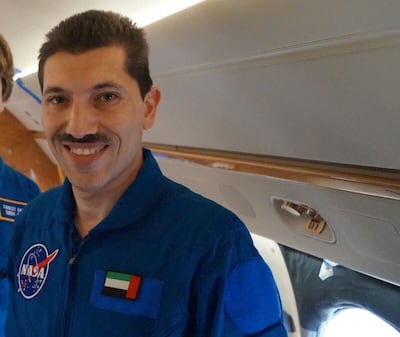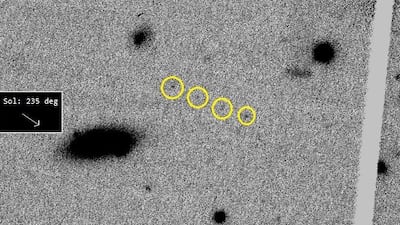An Abu Dhabi astronomer has discovered a giant asteroid believed to be the size of at least six Burj Khalifas, but the good news is it poses no threat to Earth.
Mohammad Shawkat Odeh, director of the emirate's International Astronomical Centre said the space rock was estimated to be between 5km and 10km in diameter, dwarfing Dubai's 830-metre tall Burj Khalifa.
He identified the asteroid while examining data captured by the Pan-STARRS 2 telescope at Haleakala Observatory in Hawaii.
"At this point, what we know is that it is a faint asteroid and not a bright one. Hence, we do not know much about its parameters including its size," he told The National.
"We think it is of normal size with a diameter of anything between five to 10 km."
He said the asteroid orbits the Sun once every four years at a distance of approximately 375 million km, and had been photographed several times before its discovery, with earlier observations dating to 2006.
The initial discovery certificate for the asteroid, temporarily named '2022 UY56', has been issued to Mr Odeh.
The International Astronomical Union will later assign a permanent name and officially recognise the discoverer after completing extensive observations and allowing for precise orbital calculations.
No danger to life on Earth
The asteroid discovery, Mr Odeh explained, is a significant topic in astronomy as scientists are always concerned these rocky objects could pose a danger to Earth.
He added that the '2022 UY56' follows a somewhat elliptical orbit and is not harmful to the Earth.
"It is located between Mars and Jupiter in the asteroid belt where 90 per cent of asteroids are usually found," he said.
The discovery followed the meticulous analysis of astronomical images provided by a Nasa-supported programme and in collaboration with global partners, including Hardin-Simmons University in Texas and the Catalina Sky Survey project, International Astronomical Centre President Khalfan bin Sultan Al Nuaimi announced on Monday.
Khadijah Ahmad, Operations Manager at Dubai Astronomy Group, said the discovery of the new asteroid will encourage more people to search for asteroids.
While space research and asteroid discovery are growing fields in the UAE, she said the number of people actively involved in this field is still relatively small.
Watch: Asteroid samples brought back to Earth
"The discovery by Mr Odeh is particularly unique and highlights the impact of dedicated individuals in advancing asteroid discovery and bridging the gap in funding and resources," said Ms Ahmad.
She said the Astronomy Group offers courses in archival data mining through platforms like Galaxy Zoo, Nasa's Planetary Data System and AstroData among others, where people can search for their own asteroids using both human input and automated tools. "While AI tools are commonly used, the human eye offers better insights."
The impressive find comes as the UAE seeks to deepen its knowledge of asteroids.
Emirates Mission to the Asteroid Belt (EMA) is scheduled for launch in 2028.
Supported by the $1 billion UAE Space Fund, the mission will take 13 years, including a six-year spacecraft development phase followed by a seven-year journey to the asteroid belt.
The MBR Explorer spacecraft will undertake a five-billion-km voyage, and will conduct close fly-bys of seven asteroids, with the first expected encounter in February 2030, marking the beginning of an extensive exploration mission.
Nasa asteroid smashes into asteroid - in pictures
Terror attacks in Paris, November 13, 2015
- At 9.16pm, three suicide attackers killed one person outside the Atade de France during a foootball match between France and Germany
- At 9.25pm, three attackers opened fire on restaurants and cafes over 20 minutes, killing 39 people
- Shortly after 9.40pm, three other attackers launched a three-hour raid on the Bataclan, in which 1,500 people had gathered to watch a rock concert. In total, 90 people were killed
- Salah Abdeslam, the only survivor of the terrorists, did not directly participate in the attacks, thought to be due to a technical glitch in his suicide vest
- He fled to Belgium and was involved in attacks on Brussels in March 2016. He is serving a life sentence in France
Navdeep Suri, India's Ambassador to the UAE
There has been a longstanding need from the Indian community to have a religious premises where they can practise their beliefs. Currently there is a very, very small temple in Bur Dubai and the community has outgrown this. So this will be a major temple and open to all denominations and a place should reflect India’s diversity.
It fits so well into the UAE’s own commitment to tolerance and pluralism and coming in the year of tolerance gives it that extra dimension.
What we will see on April 20 is the foundation ceremony and we expect a pretty broad cross section of the Indian community to be present, both from the UAE and abroad. The Hindu group that is building the temple will have their holiest leader attending – and we expect very senior representation from the leadership of the UAE.
When the designs were taken to the leadership, there were two clear options. There was a New Jersey model with a rectangular structure with the temple recessed inside so it was not too visible from the outside and another was the Neasden temple in London with the spires in its classical shape. And they said: look we said we wanted a temple so it should look like a temple. So this should be a classical style temple in all its glory.
It is beautifully located - 30 minutes outside of Abu Dhabi and barely 45 minutes to Dubai so it serves the needs of both communities.
This is going to be the big temple where I expect people to come from across the country at major festivals and occasions.
It is hugely important – it will take a couple of years to complete given the scale. It is going to be remarkable and will contribute something not just to the landscape in terms of visual architecture but also to the ethos. Here will be a real representation of UAE’s pluralism.
Test
Director: S Sashikanth
Cast: Nayanthara, Siddharth, Meera Jasmine, R Madhavan
Star rating: 2/5
Paatal Lok season two
Directors: Avinash Arun, Prosit Roy
Stars: Jaideep Ahlawat, Ishwak Singh, Lc Sekhose, Merenla Imsong
Rating: 4.5/5
Specs
Engine: 51.5kW electric motor
Range: 400km
Power: 134bhp
Torque: 175Nm
Price: From Dh98,800
Available: Now
Dengue%20fever%20symptoms
%3Cul%3E%0A%3Cli%3EHigh%20fever%3C%2Fli%3E%0A%3Cli%3EIntense%20pain%20behind%20your%20eyes%3C%2Fli%3E%0A%3Cli%3ESevere%20headache%3C%2Fli%3E%0A%3Cli%3EMuscle%20and%20joint%20pains%3C%2Fli%3E%0A%3Cli%3ENausea%3C%2Fli%3E%0A%3Cli%3EVomiting%3C%2Fli%3E%0A%3Cli%3ESwollen%20glands%3C%2Fli%3E%0A%3Cli%3ERash%3C%2Fli%3E%0A%3C%2Ful%3E%0A%3Cp%3EIf%20symptoms%20occur%2C%20they%20usually%20last%20for%20two-seven%20days%3C%2Fp%3E%0A
UAE currency: the story behind the money in your pockets
WOMAN AND CHILD
Director: Saeed Roustaee
Starring: Parinaz Izadyar, Payman Maadi
Rating: 4/5
FULL%20RESULTS
%3Cp%3E%3Cstrong%3EMiddleweight%20%3C%2Fstrong%3E%3C%2Fp%3E%0A%3Cp%3EEslam%20Syaha%20(EGY)%20bt%20Robin%20Roos%20(SWE)%20%0D%3Cbr%3E%3Cstrong%3E%0D%3Cbr%3EWelterweight%20%3C%2Fstrong%3E%3C%2Fp%3E%0A%3Cp%3EAlex%20da%20Silva%20(BRA)%20bt%20Bagyash%20Zharmamatov%20(KGZ)%20%0D%3Cbr%3EMurodov%20Samandar%20(TJK)%20bt%20Lucas%20Sampaio%20(BRA)%20%0D%3Cbr%3EShakhban%20Alkhasov%20(RUS)%20bt%20Salamat%20Orozakunov%20(KGZ)%0D%3Cbr%3EKhotamjon%20Boynazarov%20(UZB)%20bt%20Mikail%20Bayram%20(FRA)%20%0D%3Cbr%3E%0D%3Cbr%3E%3Cstrong%3EBantamweight%20%3C%2Fstrong%3E%0D%3Cbr%3EJieleyisi%20Baergeng%20(CHN)%20bt%20Xavier%20Alaoui%20(CAN)%20%0D%3Cbr%3E%0D%3Cbr%3E%3Cstrong%3EFlyweight%20%3C%2Fstrong%3E%0D%3Cbr%3ERashid%20Vagabov%20(RUS)%20bt%20Lun%20Qui%20(CHN)%20%0D%3Cbr%3EYamato%20Fujita%20(JPN)%20bt%20Furkatbek%20Yokubov%20(UZB)%20%0D%3Cbr%3EAaron%20Aby%20(WLS)%20bt%20Joevincent%20So%20(PHI)%20%0D%3Cbr%3E%0D%3Cbr%3E%3Cstrong%3ECatchweight%20176lb%20%3C%2Fstrong%3E%0D%3Cbr%3EMark%20Hulm%20(RSA)%20bt%20Erkin%20Darmenov%20(KAZ)%20%0D%3Cbr%3E%0D%3Cbr%3E%3Cstrong%3ECatchweight%20160lb%20%3C%2Fstrong%3E%0D%3Cbr%3ERustam%20Serbiev%20(BEL)%20bt%20Anar%20Huseyinov%20(AZE)%20%0D%3Cbr%3E%0D%3Cbr%3E%3Cstrong%3ECatchweight%20150lb%20%3C%2Fstrong%3E%3C%2Fp%3E%0A%3Cp%3EIslam%20Reda%20(EGY)%20bt%20Ernie%20Braca%20(PHI)%0D%3Cbr%3E%0D%3Cbr%3E%3Cstrong%3EFlyweight%20(women)%3C%2Fstrong%3E%20%0D%3Cbr%3EBaktygul%20Kurmanbekova%20(KGZ)%20bt%20Maria%20Eugenia%20Zbrun%20(ARG)%20%0D%3Cbr%3E%3C%2Fp%3E%0A
Specs
Engine: Electric motor generating 54.2kWh (Cooper SE and Aceman SE), 64.6kW (Countryman All4 SE)
Power: 218hp (Cooper and Aceman), 313hp (Countryman)
Torque: 330Nm (Cooper and Aceman), 494Nm (Countryman)
On sale: Now
Price: From Dh158,000 (Cooper), Dh168,000 (Aceman), Dh190,000 (Countryman)
Countries recognising Palestine
France, UK, Canada, Australia, Portugal, Belgium, Malta, Luxembourg, San Marino and Andorra
more from Janine di Giovanni
OPTA'S PREDICTED TABLE
1. Liverpool 101 points
2. Manchester City 80
3. Leicester 67
4. Chelsea 63
5. Manchester United 61
6. Tottenham 58
7. Wolves 56
8. Arsenal 56
9. Sheffield United 55
10. Everton 50
11. Burnley 49
12. Crystal Palace 49
13. Newcastle 46
14. Southampton 44
15. West Ham 39
16. Brighton 37
17. Watford 36
18. Bournemouth 36
19. Aston Villa 32
20. Norwich City 29
match info
Maratha Arabians 138-2
C Lynn 91*, A Lyth 20, B Laughlin 1-15
Team Abu Dhabi 114-3
L Wright 40*, L Malinga 0-13, M McClenaghan 1-17
Maratha Arabians won by 24 runs
GIANT REVIEW
Starring: Amir El-Masry, Pierce Brosnan
Director: Athale
Rating: 4/5
Race card
4pm Al Bastakiya Listed US$300,000 (Dirt) 1,900m
4.35pm Mahab Al Shimaal Group 3 $350,000 (D) 1,200m
5.10pm Nad Al Sheba Turf Group 3 $350,000 (Turf) 1,200m
5.45pm Burj Nahaar Group 3 $350,000 (D) 1,600m
6.20pm Jebel Hatta Group 1 $400,000 (T) 1,800m
6.55pm Al Maktoum Challenge Round-3 Group 1 $600,000 (D) 2,000m
7.30pm Dubai City Of Gold Group 2 $350,000 (T) 2,410m
The National selections:
4pm Zabardast
4.35pm Ibn Malik
5.10pm Space Blues
5.45pm Kimbear
6.20pm Barney Roy
6.55pm Matterhorn
7.30pm Defoe
MEYDAN%20RACECARD
%3Cp%3E%3Cstrong%3E6pm%20%3C%2Fstrong%3EArabian%20Adventures%20%E2%80%93%20Maiden%20(TB)%20Dh82%2C500%20(Dirt)%201%2C200m%0D%3Cbr%3E%3Cstrong%3E6.35pm%20%3C%2Fstrong%3EEmirates%20Sky%20Cargo%20%E2%80%93%20Handicap%20(TB)%2087%2C500%20(D)%202%2C000m%0D%3Cbr%3E%3Cstrong%3E7.10pm%20%3C%2Fstrong%3EEmirates%20Holiday%20%E2%80%93%20Maiden%20(TB)%20Dh82%2C500%20(D)%201%2C400m%0D%3Cbr%3E%3Cstrong%3E7.45pm%20%3C%2Fstrong%3EEmirates%20Skywards%20%E2%80%93%20Handicap%20(TB)%20Dh87%2C500%20(D)%201%2C400m%0D%3Cbr%3E%3Cstrong%3E8.20pm%3C%2Fstrong%3E%20Emirates%20Airline%20%E2%80%93%20Handicap%20(TB)%20Dh105%2C000%20(D)%201%2C600m%0D%3Cbr%3E%3Cstrong%3E8.55pm%20%3C%2Fstrong%3EEmirates%20Airline%20%E2%80%93%20Handicap%20(TB)%20Dh105%2C000%20(D)%201%2C900m%0D%3Cbr%3E%3Cstrong%3E9.30pm%20%3C%2Fstrong%3EEmirates.com%20%E2%80%93%20Handicap%20(TB_%20Dh87%2C500%20(D)%201%2C200m%3C%2Fp%3E%0A
Essentials
The flights
Etihad and Emirates fly direct from the UAE to Delhi from about Dh950 return including taxes.
The hotels
Double rooms at Tijara Fort-Palace cost from 6,670 rupees (Dh377), including breakfast.
Doubles at Fort Bishangarh cost from 29,030 rupees (Dh1,641), including breakfast. Doubles at Narendra Bhawan cost from 15,360 rupees (Dh869). Doubles at Chanoud Garh cost from 19,840 rupees (Dh1,122), full board. Doubles at Fort Begu cost from 10,000 rupees (Dh565), including breakfast.
The tours
Amar Grover travelled with Wild Frontiers. A tailor-made, nine-day itinerary via New Delhi, with one night in Tijara and two nights in each of the remaining properties, including car/driver, costs from £1,445 (Dh6,968) per person.
You might also like to read
Results
2pm: Maiden (TB) Dh60,000 (Dirt) 1,200m, Winner: Mouheeb, Tom Marquand (jockey), Nicholas Bachalard (trainer)
2.30pm: Handicap (TB) Dh68,000 (D) 1,200m, Winner: Honourable Justice, Royston Ffrench, Salem bin Ghadayer
3pm: Handicap (TB) Dh84,000 (D) 1,200m, Winner: Dahawi, Antonio Fresu, Musabah Al Muhairi
3.30pm: Conditions (TB) Dh100,000 (D) 1,200m, Winner: Dark Silver, Fernando Jara, Ahmad bin Harmash
4pm: Maiden (TB) Dh60,000 (D) 1,600m, Winner: Dark Of Night. Antonio Fresu, Al Muhairi.
4.30pm: Handicap (TB) Dh68,000 (D) 1,600m, Winner: Habah, Pat Dobbs, Doug Watson








